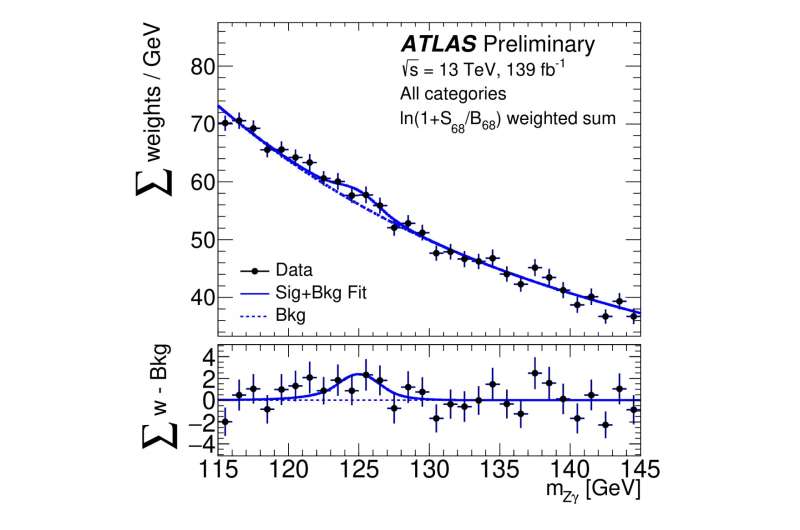ATLAS Experiment searches for rare Higgs boson decays into a photon and a Z boson

The Higgs boson was discovered by the ATLAS and CMS Collaborations at CERN's Large Hadron Collider (LHC) in 2012 through its decays into pairs of photons, W bosons and Z bosons. Since then, physicists at these experiments have gained great insight into the properties of the Higgs boson through the study of its different production and decay processes. Decays to pairs of tau leptons and bottom quarks were established, as was the coupling to top quarks. However, the question remains whether the Higgs boson may also interact with yet-unknown particles or forces.
Eight years after its discovery, ATLAS has observed nearly 90% of all Higgs-boson decays predicted by the Standard Model. A rare decay of the Higgs boson that has yet to be seen is that to a Z boson and a photon (Zγ). This decay is of particular interest to physicists as it proceeds through processes involving heavy "virtual" (possibly new) particles, which could modify its rate.
The ATLAS Collaboration has released a new result searching for the Higgs-boson decay to Zγ. This result uses the full LHC Run-2 dataset, analysing almost four times as many Higgs-boson events as the previous ATLAS result.
According to the Standard Model, 0.15% of Higgs bosons decay to Zγ – a rate comparable to the Higgs-boson decay to two photons, one of the discovery channels. However, unlike photons, Z bosons decay almost instantly and cannot be directly observed. Instead, the Z bosons are reconstructed through their decays into electron or muon pairs. As less than 7% of Z bosons decay in this way, only a tiny expected signal of about 1 in 10,000 Standard Model Higgs bosons can be probed.

To separate Higgs-boson events from abundant background processes, ATLAS physicists performed a fit to the distribution of the mass of the reconstructed Z boson and photon. This fit simultaneously determines the number of signal and background events by utilising the different shapes of the signal (narrow peak) and background processes (smooth distribution).
To enhance the sensitivity of the search, physicists separated the potential Higgs-boson events into multiple categories, each with different expected signal-to-background ratios. One of these categories, where the Higgs boson is produced together with two forward jets via the interaction of two weak bosons, used a multivariate discriminant (or "boosted decision tree") to distinguish it from the other Higgs-boson production modes. Other categories were characterised by the momentum of the photon or the Higgs-boson candidate, or whether the Z boson decayed into electron or muon pairs.
Physicists examined all of these categories simultaneously, studying the distribution of the mass of the reconstructed Z boson and photon in selected events to look for an excess caused by the decays of Higgs bosons to Zγ. Figure 2 shows the Z-boson-plus-photon mass distribution combined over all categories, with the results of the fit overlaid.
A signal yield about twice that expected from the Standard Model, equivalent to a significance of 2.2 standard deviations (5 needed to declare an observation) was found in the data. The result allows ATLAS physicists to exclude, at a 95% confidence level, production rates more than 3.6 larger than what is predicted by the Standard Model. More data are needed to hone in on the Higgs boson decay to Zγ.
More information: A search for the Zγ decay mode of the Higgs boson in proton-proton collisions at 13 TeV with the ATLAS detector, arXiv:2005.05382 [hep-ex] arxiv.org/abs/2005.05382
Provided by ATLAS Experiment



















